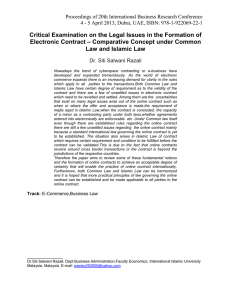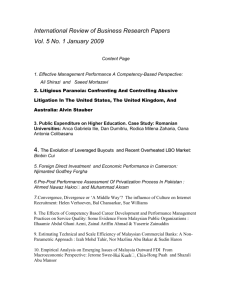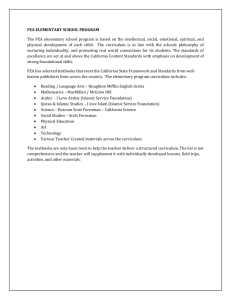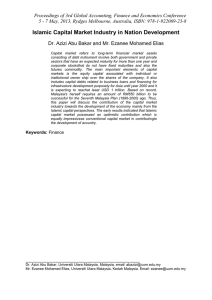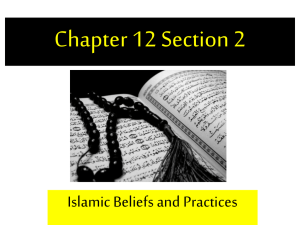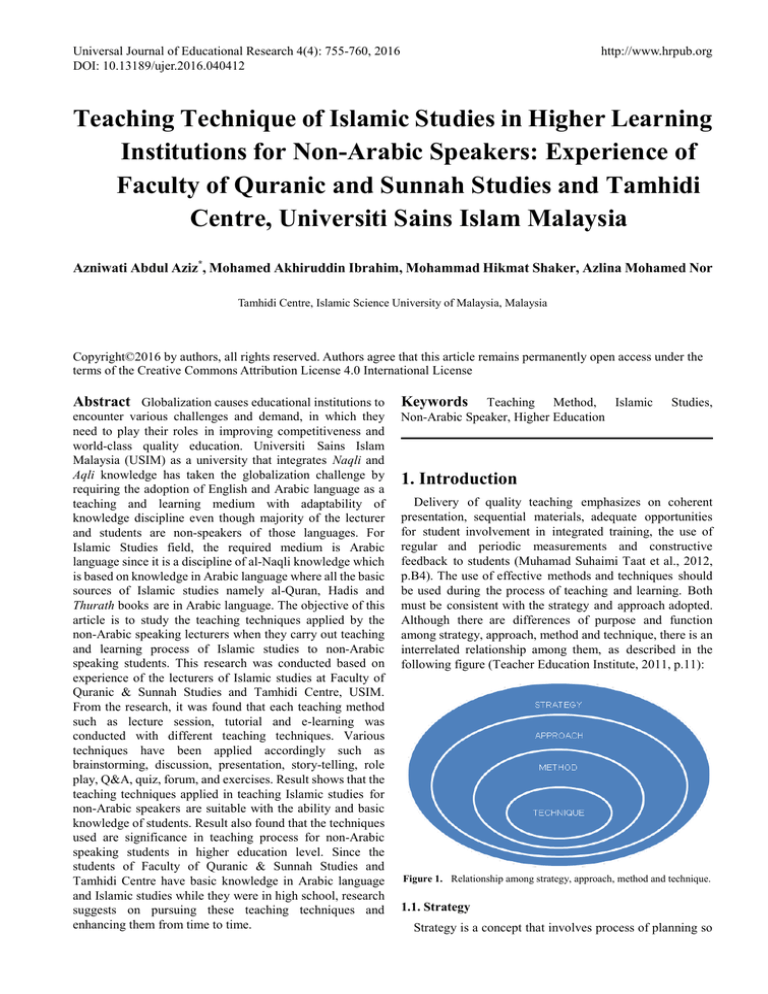
Universal Journal of Educational Research 4(4): 755-760, 2016
DOI: 10.13189/ujer.2016.040412
http://www.hrpub.org
Teaching Technique of Islamic Studies in Higher Learning
Institutions for Non-Arabic Speakers: Experience of
Faculty of Quranic and Sunnah Studies and Tamhidi
Centre, Universiti Sains Islam Malaysia
Azniwati Abdul Aziz*, Mohamed Akhiruddin Ibrahim, Mohammad Hikmat Shaker, Azlina Mohamed Nor
Tamhidi Centre, Islamic Science University of Malaysia, Malaysia
Copyright©2016 by authors, all rights reserved. Authors agree that this article remains permanently open access under the
terms of the Creative Commons Attribution License 4.0 International License
Abstract Globalization causes educational institutions to
encounter various challenges and demand, in which they
need to play their roles in improving competitiveness and
world-class quality education. Universiti Sains Islam
Malaysia (USIM) as a university that integrates Naqli and
Aqli knowledge has taken the globalization challenge by
requiring the adoption of English and Arabic language as a
teaching and learning medium with adaptability of
knowledge discipline even though majority of the lecturer
and students are non-speakers of those languages. For
Islamic Studies field, the required medium is Arabic
language since it is a discipline of al-Naqli knowledge which
is based on knowledge in Arabic language where all the basic
sources of Islamic studies namely al-Quran, Hadis and
Thurath books are in Arabic language. The objective of this
article is to study the teaching techniques applied by the
non-Arabic speaking lecturers when they carry out teaching
and learning process of Islamic studies to non-Arabic
speaking students. This research was conducted based on
experience of the lecturers of Islamic studies at Faculty of
Quranic & Sunnah Studies and Tamhidi Centre, USIM.
From the research, it was found that each teaching method
such as lecture session, tutorial and e-learning was
conducted with different teaching techniques. Various
techniques have been applied accordingly such as
brainstorming, discussion, presentation, story-telling, role
play, Q&A, quiz, forum, and exercises. Result shows that the
teaching techniques applied in teaching Islamic studies for
non-Arabic speakers are suitable with the ability and basic
knowledge of students. Result also found that the techniques
used are significance in teaching process for non-Arabic
speaking students in higher education level. Since the
students of Faculty of Quranic & Sunnah Studies and
Tamhidi Centre have basic knowledge in Arabic language
and Islamic studies while they were in high school, research
suggests on pursuing these teaching techniques and
enhancing them from time to time.
Keywords Teaching Method, Islamic
Non-Arabic Speaker, Higher Education
Studies,
1. Introduction
Delivery of quality teaching emphasizes on coherent
presentation, sequential materials, adequate opportunities
for student involvement in integrated training, the use of
regular and periodic measurements and constructive
feedback to students (Muhamad Suhaimi Taat et al., 2012,
p.B4). The use of effective methods and techniques should
be used during the process of teaching and learning. Both
must be consistent with the strategy and approach adopted.
Although there are differences of purpose and function
among strategy, approach, method and technique, there is an
interrelated relationship among them, as described in the
following figure (Teacher Education Institute, 2011, p.11):
Figure 1. Relationship among strategy, approach, method and technique.
1.1. Strategy
Strategy is a concept that involves process of planning so
756
Teaching Technique of Islamic Studies in Higher Learning Institutions for Non-Arabic Speakers: Experience
of Faculty of Quranic and Sunnah Studies and Tamhidi Centre, Universiti Sains Islam Malaysia
as to determine actions that should be taken in achieving the
intended goals. In teaching and learning context, strategy
means ways or steps or actions that must be implemented in
order to achieve the objectives of teaching and learning.
Strategy therefore, focuses on achievement or learning
outcomes (Teacher Education Institute, 2011, p.11).
1.2. Approach
There are various types of approaches which are Inductive
Approach, Deductive Approach, Eclectic Approach,
Communicative Approach, Interactional Approach and
Integrated Approach (Teacher Education Institute, 2011,
p.13). According to Parera (1986), approach is the
background of philosophy or opinion about main idea to be
debated and is an axiom that is generally accepted statement
form the basis of a description (Chang Lee Hoon, p.17).
Approach is also a way to deal with a subject, namely how a
subject can be taught based on its objectives, and hence, it
becomes a systematic set of theory (Mok Soon Sang, 1992).
1.3. Method
Method is a systematic series of actions to achieve the
objectives of the learning outcomes in short term. Teaching
method is a way to accomplish a learning objective through
organized presentation delivery (Mok Soon Sang, 1992). It
also means moving towards a learning objective which has
been planned and organized (Sharifah Alwiah, 1986).
Method is also a means to achieve a goal; therefore,
whatever ways that teachers do to make the students
understand so as to achieve the teaching objectives, then it is
a method (Hasan Langgulung, 1981). Definition of method
is also described as a teaching activity that consists of
organized steps, and in each step, there is a planned skill and
practice. Teaching method is not the main purpose of
teaching, but it is a wasilah, that is a way to achieve teaching
objective (Abu Saleh, 1988).
This therefore means that teaching method is a plan or
procedure adopted to implement teaching in an orderly,
organized and systematic manner. Method is an organized,
continuous teaching step that is structured and should be
implemented in order to accomplish a teaching objective.
Among the methods proposed for use in teaching and
learning are natural method, grammar translation method,
direct method, Hafaz method, linguistic method,
code-cognitive method, oral-aural method, natural method,
soldier method, psychological method and specific method
(Teacher Education Institute, 2011, p.12).
1.4. Technique
According to Edward M. Anthony, technique is a trick or
strategy or tactics used by teachers to achieve maximum
results immediately in teaching a specific part of a language.
In general, technique is what is seen in the classroom
(Azman Wan Chik, 1987) that is teacher’s skills in the
management and implementation of teaching methods in
teaching and learning activities. If a teacher teaches
language using advanced communication tools in a language
laboratory, then it's a technique (Muhammad Azhar et al.,
2012, p.894). If an Islamic Education teacher teaches a
student to memorize al-Quran by listening to the recitation in
cassette, then it is a technique. In conclusion, technique is a
control of an organization that really happens in classrooms
where it is used to achieve an objective. There are various
types of technique namely role-play, games, drill,
storytelling, discussion, debate, quizzes, brainstorming,
question and answer, simulation, drama and inquiry
techniques (Abdul Rasidet al., 2013, pp.47-49).
Based on the definitions described above, it can be
generally understood that strategies the planning of teaching
such
as
teacher-centered,
student-centered,
and
material-centered. Approach is a way to deal with a subject
that is how a subject is taught according to its objectives. In
addition, method is a systematic series of actions to achieve
the learning objectives in a short term. Teaching method is a
way to approach a learning objective through structured
delivery. Technique, on the other hand, is a teacher’s skill in
managing and implementing a teaching and learning activity
(Muhamad Suhaimi Taat et al., 2012, p.B4).
2. Background of Studies in the Faculty
of Quranic and Sunnah Studies (Fpqs)
and in Tamhidi Centre, Islamic
Science University of Malaysia (Usim)
2.1. Faculty of Quranic and Sunnah Studies (FPQS)
The objective of the establishment of FPQS is to uphold
the Quran and Sunnah studies in mainstream education by
emphasizing the use of information technology in its
teaching and research. In addition, it also seeks to expand
Islamic beliefs by providing more opportunities for
researchers and educators to study, research and disseminate
knowledge and wisdom contained in the holy book of Quran
and Sunnah to the society and country (Academic Division,
2005, p.18).
In order to ensure that these goals are accomplished,
FPQS has established three programs, namely Bachelor of
Quranic and Sunnah Studies with Honours, Bachelor of
Quranic Studies with Multimedia with Honors and Bachelor
of Sunnah Studies with Information Management with
Honours (Kandil et.al., 2007, p.78).
2.2. Tamhidi Centre, Islamic Science University of
Malaysia (USIM)
USIM Tamhidi Programme is a programme for SPM
leavers that prepare them for their First Degree. Tamhidi is
an Arabic word which means 'Setup' which is similar to the
terms 'Matriculation' in the Ministry of Education and the
Universal Journal of Educational Research 4(4): 755-760, 2016
International Islamic University Malaysia, 'Foundation' at
the University of Malaya, 'Foundation Year' at Universiti
Teknologi Malaysia or similar to the pre-university
programme (STPM , HSC or A 'Level). Therefore Tamhidi
Programme is equivalent to 'foundation' or fundamental
programs conducted by the above-said universities. There
are 5 Tamhidi programmes offered, namely Tamhidi of
Medicine, Tamhidi of Science and Technology, Tamhidi of
Syariah and Law, Tamhidi of Accounting and Muamalat and
Tamhidi of Dentistry (http://tamhidi.usim.edu.my/).
An essential prerequisite for entrance into any academic
center or faculty in USIM is passed Arabic subjects in SPM
(Tamhdi Centre, 2005, p. 9). Students who do not have any
basics in Arabic language are not eligible to apply since the
teaching and learning system in USIM is using English and
Arabic only as a medium of instruction. Arabic language
courses are compulsory university courses that must be
learned by all students from all fields of specialization.
2.3. Position of Islamic Studies at the Faculty of Quran
and Sunnah (FPQS) and in Tamhidi Centre
The vision of FPQS is to uphold al-Quran and Sunnah in
producing man that is based on Islamic education and recent
technology that is able to contribute to the society, nation and
the whole world (Academic Division, 2005, p.19). Therefore,
the courses of Islamic studies are the basic or main courses
for all programmes offered.
Unlike FPQS, only one of the five programmes offered by
Tamhidi Centre requires Islamic studies course as the main
course namely Tamhidi of Syariah and Law programme.
However, to realize the objectives of the university that is
committed to producing Muslim professional graduates who
not only have expertise in the field of Medical Sciences,
Science, Technology, Engineering, Economics, Accounting,
and Muamalat Syariah and Law, but also possess good ethics
and proper understanding about Islam without neglecting
other programmes (Academic Division, 2005, p.13).
Tamhidi Centre has provided Islamic studies courses as
compulsory courses that are relevant and significant to the
five programs offered. Similar to the practice in FPQS, the
teaching and learning, learning modules and reference books
for all courses of Islamic studies courses are in Arabic.
Since the establishment of USIM until now, all the
lecturers and students of Islamic studies courses in Tamhidi
Centre are non-Arabic speakers. However, just like the
scenario in FPQS, the lecturers are able to speak in Arabic as
they used to further their education in countries like Jordan,
Egypt, and Morocco. On the other hand, the students have
the basic skills to understand and speak in Arabic as they
learnt Arabic in secondary school that makes it as a
compulsory subject.
3. Methods and Techniques of Teaching
Islamic Studies
757
According to Zahiah Haris (2011), in order to ensure the
teaching and learning process can be implemented
effectively and meet the objectives set, these are the rules
recommended by the Division of Teacher Education for each
field in Islamic Education, namely: First, Field of Al-Quran
Recitation and Memorization. The proposed methods for
this field are talaqqi musyafahah, tikrar, hafazan, and tasmi’.
Second, Field of Aqidah. Under this particular field, the
proposed
techniques
are
discussion,
workshops,
brainstorming, reflection, and teaching with computer. Third,
Field of Ibadah. For this field, the proposed methods are
discussion,
brainstorming,
practical,
simulation,
collaboration, and co-operative learning. Fourth, Field of
Akhlak and Morality. The suggested teaching techniques
under this field are lectures, discussions, simulations, forum,
future studies, contextual teaching, reflection, and group
activities.
According to a study done by Ab. Halim Tamuri (2010),
question
and
answer
technique,
demonstration,
memorization, drills and lectures are techniques commonly
used by teachers when teaching. In addition, based on a study
conducted by Kamarul Azmi Jasmi (2011), generally the
majority of outstanding teachers of Islamic education are
using questionnaires, group discussions, student-teacher
discussions, reciting verses from the Quran, demonstrations,
motivation, memorizing individually, memorizing in groups
and practice in their teaching. However, storytelling and
brainstorming techniques are used more frequently by
excellent Islamic Education teachers in urban areas.
Generally, the course delivery methods in higher
education are in the forms of lectures, tutorials, and
e-learning as well as individual or group assignments,
discussions and presentations (Course Outline, Tamhidi
Centre, 2013). It is very apparent that educators will apply
and implement various teaching techniques during lecture
or tutorial in order to ensure the teaching objectives are met.
Hence, the primary challenge for Islamic studies courses in
USIM is when the lecturers need to deal with students who
are not native speakers of Arabic and in general do not have
the experience of studying with full Arabic language
medium in schools. Students' ability to understand the
content of lessons in Arabic during lecture is the main
objective of each lesson, but the lecturer cannot and should
not simply translate the content into Bahasa Malaysia or
English. This definitely violates teaching ethics in USIM.
3.1. Question-answer Technique
Lecturing is a common method frequently used by
majority of lecturers in which one-way teaching takes place.
In order to reinforce this technique, lecturer should give
about ten to twenty minutes for the students to ask questions
after the lecture has ended (Zahiah Haris@Harith &
Mustapha Kamal Ahmad Kassim, 2011, p. 286).
This technique is also implemented through the lecturer
asking questions relating to the subject matter and students
need to respond accordingly. Questions are raised after the
758
Teaching Technique of Islamic Studies in Higher Learning Institutions for Non-Arabic Speakers: Experience
of Faculty of Quranic and Sunnah Studies and Tamhidi Centre, Universiti Sains Islam Malaysia
completion of briefing sessions for each sub-topic. This
technique is intended to detect the level of understanding of
students, encourage students to explain information clearly
as well as to assess the ability to speak in Arabic. This
technique will be more effective when planned and quality
questions are asked as it can help sharpen students’ thinking
skills while creating a more dynamic and efficient learning
environment.
3.2. Role-play Technique
This technique is usually used spontaneously by the
lecturers. When majority of students cannot understand the
situation explained, the lecturer will ask some of the students
who are able to understand it well to dramatize it. This
technique is a form of drama that does not require scripts
memorization and the lecturer will only act as a facilitator
before the play starts. Students who act in this technique will
try to explain a situation to other students through acting
and language styles that can be understood easily among
them.
Simulation method is a controlled learning situation and
deliberately created in which it simulates the real situation
with the aim of training to solve a problem. There are two
types of methods, namely sociodrama and role-play.
Sociodrama is acting activities based upon a story. On the
other hand, role-play is acting spontaneously involving a
group of students (Zahiah Haris @ Harith & Mustapha
Kamal Ahmad Kassim, 2011, p. 286), Not only is this
technique able to turn a very positive learning environment,
but also it can build positive qualities in students. Habit of
helping others to understand the lesson content can be
fostered indirectly by using this technique.
3.3. Story-telling Technique
One purpose of this technique is to give simple examples
of the subject content which can be understood easily and
remembered well by the students. Most lecturers use
appropriate personal experiences and present it in a simple,
easy and effortless language style. Good intonation and body
language help students to better understand the story and its
relationship with the teaching content.
A study conducted by Maimun Aqsa Lubis (2005) showed
techniques of storytelling and acting are among effective
techniques for students to think in an Islamic way, which can
encourage their interest to learn Islamic knowledge, help
them practice Islamic teachings, improve their moral and
attitude, assist them in assessing and improving their
character, building their sense of responsibility towards
themselves, their families and communities as well as help
them to be good. An appropriate story that is told in an
interesting style makes it a technique that can attract
students’ attention and concentration in teaching and
learning process. (Ee Ah Meng, 1993).
3.4. Drilling Technique
Lecturers apply drilling technique when they have to
repeat the facts learned repetitively. It aims to achieve a skill
such as pronunciation skills, or to make the students
remember and memorize important facts. Through this
technique, students need to be alert as they need to listen, see
and think about the meaning of the words according to
context.
According to the Division of Teacher Education, it is
known as tikrar technique that is suggested for the Quranic
recitation and memorization, whereby the lecturers ask the
students to read the Quran repetitively so that it can be
remembered easily (Zahiah Haris @ Harith & Mustapha
Kamal Ahmad Kassim, 2011, p. 284). It is also suitable to be
applied by the author as most Arabic words have more than
one meaning.
3.5. Discussion Technique
This technique is usually made in tutorial classes. The
purpose is to train students to express themselves excellently.
The lecturer divides the students into groups; assigns each
group to discuss among themselves while being monitored
so that the discussion is focused. After the discussion period
ends, the lecturer will ask for a report from each group. The
lecturer will encourage the students to present in a form of
speech, not through reading out loud. Indirectly, this can
enhance the students’ ability to speak in Arabic with the
correct use of language. Some lecturers use e-learning to
create forums with topics related to their subject matter.
Lecturers will participate in that online forum to monitor
any negative element in the discussion. In addition, they can
also monitor the progress of students in writing Arabic
language.
This is a very significant technique because it involves all
students in the class and they play an active role in the
discussion sessions. It aims to train students to express their
thoughtful, logical and mature views within a defined time
period, encourage students to collaborate and share ideas,
create an interest to read as it is necessary for them to make
references (Mak Soon Sang, 1993). Discussion technique is
strongly encouraged by Imam As-Syafie since a problem
could be discussed without any restrictions of giving an
opinion as long as it does not contradict with the Islamic law
(Ahmad Mohd Salleh, 2004).
3.6. Brainstorming
This technique can encourage broad, critical and creative
thinking. One advantage of brainstorming compared to other
techniques is that it is particularly suitable to train students in
communication skills. In addition to learning how to present
their views responsibly, students also learn to accept the
views of others who may not be in line with theirs. Indirectly,
this can widen the students' perspectives towards many
things particularly to knowledge and student life (Maria
Chong Abdullah etc., tt, p. 11). Effectiveness of
brainstorming session depends on some situations, whereby
Universal Journal of Educational Research 4(4): 755-760, 2016
lecturer shows a positive attitude as well as promotes
positive thinking among pupils, students' active participation,
unbiased lecturer that does not favor any individual or group
and the chosen ideas should be used accordingly.
4. Conclusion and Recommendation
Based on the situation where the teaching and learning
process is in Arabic language medium, and the teaching
modules are also in Arabic, while the students are not native
speakers of Arabic, it is recommended that the Islamic
studies lecturers to be concerned with the student's level of
mastering the language itself. This is because, based on the
study of the correlation between the ability to speak Arabic
with achievement of studying fiqh by Khairol Anwar (2010),
it is found that in order to be able to learn the Islamic values
well, it is required to have good and moderate Arabic
language skills.
According to Khairol Anwar (2010), the indicators of
Arabic skills are as follows:
1. Able to read, either reading out loud, in heart or
analytically. Reading out loud is carried out with a
loud voice and able to be understood by others.
Reading in heart is to gain understanding and get
important points. Meanwhile, reading analytically is
to train students to search for information.
2. Able to write, either the information is able to be
written well enough, or able to express opinions and
feelings in a good piece of writing.
3. Able to listen, either in identifying hijaiyyah hurufs
or phrases in matching and differentiating
information, or obtaining general information
accurately.
4. Able to speak, either to convey information orally
with simple sentences, or make a simple dialogue
well, or express opinions and feelings orally very
well.
In conclusion, given the fact that students of Faculty of
Qur'anic and Sunnah Studies and Tamhidi Centres have
some basics in Arabic and Islamic Studies, the authors found
out that the techniques implemented in teaching Islamic
studies to non-native Arabic speakers were suitable and in
accordance with students' ability and knowledge. It is also
found that the techniques used are significant in the
non-native Arabic speakers' learning process at higher
learning institution. Hence, the authors recommend the
teaching techniques to be practiced and improved from time
to time.
5. Closing
No one strategy, approach, method or technique that
works best for all courses for all students in all
circumstances. It should be changed according to
759
circumstances of time, place and students. According to
Al-Kailany and Iyad, among the important guidelines before
applying any method or technique of teaching in general,
first, it must be commensurate with the goals and objectives
of the lesson, second, it must be in line with the objectives
intended to be achieved, third, it must be in accordance with
the nature of the subjects taught, fourth, it must be suitable
with the age of students; fifth, it can be applied by
instructors to have enough time to implement it and finally,
it is in accordance with the existing facility (Muhamad
Suhaimi Taat et al., 2012, p.B4).
In addition, the teaching session will be successful with
the selection of teaching methods and techniques that can
have a profound impact not only on the understanding of
students, but also affecting and touching their heart. In this
way students will stay focus and be able to remember the
lessons faster and better.
REFERENCES
[1]
Abdul Rasid Jamian et al. ( 2013).Interaksi Lisan Dalam
Pengajaran Dan Pembelajaran Bahasa Melayu (Verbal
Interaction In Teaching And Learning Of Malay Language)
Jurnal Pendidikan Bahasa Melayu – JPBM (Malay Language
Education Journal – Mylej) Vol. 3, Number. 1 (Mei 2013):
42-51.
[2]
Abu Saleh, Muhibuddin Ahmad. (1988). Asasiyat Fi Turuq
At-Tadris Al-`Ammah. Riyadh: Dar al-Huda.
[3]
Ab. Halim Tamuri, Mohamad Khairul Azman Ajuhary.
(2010). Amalan Pengajaran Guru Pendidikan Islam Berkesan
Berteraskan Konsep Muallim. Journal Of Islamic And Arabic
Education 2(1), 43-56).
[4]
Kamarul Azmi Jasmi, Ab. Halim Tamuri, Mohd Izham Mohd
Hamzah. (2011). Kajian Kes Penggunaan Kaedah Pengajaran
Dan Pembelajaran Guru Cemerlang Pendidikan Islam (GCPI)
Sekolah Bandar Dan Luar Bandar : Satu Kajian
Perbandingan. . Jurnal Teknologi, 56 (Sains Sosial), Sept.
2011: 179–198Penerbit UTM Press, Universiti Teknologi
Malaysia.
[5]
Haji Maimun Aqsha Lubis, Roslan Hj Aspar. (2005). Kaedah
Pengajaran Pengetahuan Agama Islam Di Brunei Darussalam.
Jurnal Pendidikan 30 (2005) 141-150.
[6]
Khairol Anwar . (2010) Korelasi Antara Kemampuan
Berbahasa Arab Dengan Prestasi Belajar Fiqih Siswa Kelas
Xii MA Ali Maksum Pondok Pesantren Krapyak Yogyakarta.
[7]
Zahiah Haris @ Harith, Mustapha Kamal Ahmad Kassim.
(2011). Pendidikan Islam Kursus Perguruan Lepas Ijazah Di
Institut Pendidikan Guru Malaysia: Kaedah Dan Proses
Pengajaran Dan Pembelajaran Yang Berkesan Atikan, 1(2).
[8]
Maria Chong Abdullah, Samsilah Roslan Dan Tajularipin
Sulaiman. (T.T). Strategi Pengajaran Pembelajaran Di
Institusi Pengajian Tinggi: Satu Anjakan Paradigma. Fakulti
Pengajian Pendidikan Universiti Putra Malaysia, Selangor.
[9]
Academic Division. (2005). Buku Panduan 2005/2006
Fakulti Pengajian Quran dan Sunnah. Bandar BaruNilai:
760
Teaching Technique of Islamic Studies in Higher Learning Institutions for Non-Arabic Speakers: Experience
of Faculty of Quranic and Sunnah Studies and Tamhidi Centre, Universiti Sains Islam Malaysia
Penerbit USIM.
Rendah, Kementerian Pelajaran Malaysia.
[10] Al-Kailany, Taisir and Iyad, Mulhim.(1986). At-Taujih
Al-Fanny Fi Usul al-Tarbiyah Wat-Tadris. Beirut:
MaktabahLubnan.
[19] Kandil, Hisham Muhammad TakyEldin et al., (2007). USIM
Merintis Kejayaan (Pioneering Success). Bandar Baru Nilai:
Penerbit USIM.
[11] An-Nashmy,
Ajil
Jasim.
(1980).
Fit-Tarbiyah.Kuwait: Maktabah al-Manar.
[20] Kolej Universiti Islam Malaysia. (2005). BukuPanduan
2005/2006 Pusat Tamhidi KolejUniversiti Islam Malaysia.
Bandar BaruNilai :Penerbit USIM.
Ma`Alim
[12] Azman Wan Chik. (1987). KaedahHayatiAmali. Kuala
Lumpur: KaryaBistari.
[13] Chang Lee Hoon. Pendekatan Dalam Pendidikan Moral,
Fakulti Pendidikan, Universiti Malaya. An article in
http://www.academia.edu.
[14] Faculty of Quranic & Sunnah Studies. (2014). Course Outline
of Faculty of Quranic & Sunnah Studies. Universiti Sains
Islam Malaysia.
[15] Faculty of Quranic and Sunnah Studies. Universiti Sains
Islam Malaysia. http://fpqs.usim.edu.my. 29 October 2014.
[16] Hadijah binti kodiron. (2010). Komponen Penyampaian Yang
Perlu diberi perhatian dalam merancang keberkesanan Proses
Pengajaran dan pembelajaran dan kaedah penilaian bagi
menilai keberkesanan Proses Pengajaran dan Pembelajaran
serta kelebihan dan ke kurangannya. Penilaian Tahap
Kecekapan Kementerian Pengajian Tinggi (Tahap Kecekapan
4) Siri 2/2010.
[17] Hasan Langgulung. (1981).Beberapa Tinjauan
Pendidikan Islam. Kuala Lumpur: Pustaka Antara.
Dalam
[18] Institut Pendidikan Guru. (2011). Modul Bahasa Melayu
BMM 3117-Kaedah Pengajaran Bahasa Melayu Sekolah
[21] Mok Soon Seng. (1992). Pedagogi 2: Strategi Pengajaran
Pembelajaran Mikro. Kuala Lumpur: Kumpulan Budiman.
[22] Muhamad SuhaimiTaat et al. (2012). Pengajaran dan
penyampaian yang berkesan. UtusanBorneo .B4.
[23] Muhammad, Azharet al. (2012). Kemahiran bertutur dalam
pengajaran dan pembelajaran Bahasa Arab. In: Seminar
Antarabangsa
Perguruandan
Pendidikan
Islam
[SEAPPI2012] (International Seminar on Teacher and
Islamic Education [SEAPPI2012]), 8-9 March 2012, Le
Grandeur Palm Resort, Senai, Johor Bahru.
[24] Sharifah Alwitah Alsagoff. (1986). Ilmu Pendidikan:
Pedagogi . Kuala Lumpur: Heineman Asia.
[25] Tamhidi Centre, Universiti Sains Islam Malaysia. (2013).
Course Outline.
[26] Tamhidi Centre, Universiti Sains Islam
http://tamhidi.usim.edu.my/. 25 October 2014.
Malaysia.
[27] Universiti Sains Islam Malaysia. (2012). Program Tamhidi:
Program Pengajian dan Syarat Kemasukan
[28] (Tamhidi Programs and Admission Requirements).

